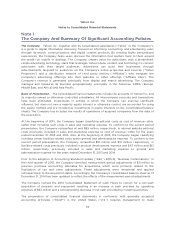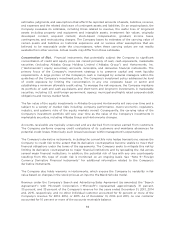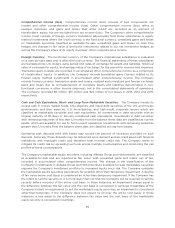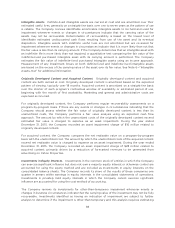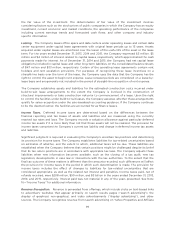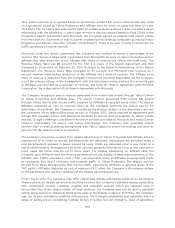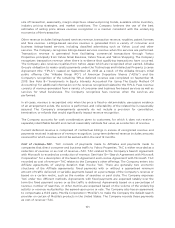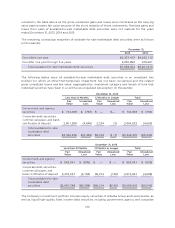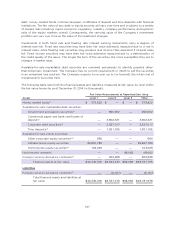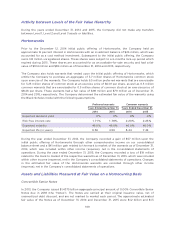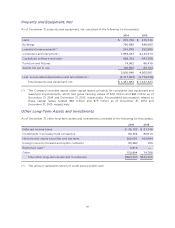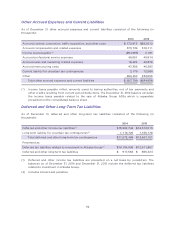Yahoo 2015 Annual Report Download - page 107
Download and view the complete annual report
Please find page 107 of the 2015 Yahoo annual report below. You can navigate through the pages in the report by either clicking on the pages listed below, or by using the keyword search tool below to find specific information within the annual report.based on the implied volatility of publicly traded options on its common stock, with a term of one
year or greater. The Company believes that implied volatility calculated based on actively traded
options on its common stock is a better indicator of expected volatility and future stock price trends
than historical volatility. The assumptions used in calculating the fair value of stock-based awards
represent the Company’s best estimates, but these estimates involve inherent uncertainties and the
application of management judgment. As a result, if factors change and the Company uses different
assumptions, the Company’s stock-based compensation expense could be materially different in the
future. In addition, the Company is required to estimate the expected pre-vesting award forfeiture
rate, as well as the probability that performance conditions that affect the vesting of certain awards
will be achieved, and only recognizes expense for those shares expected to vest. The Company
estimates the forfeiture rate based on historical experience of the Company’s stock-based awards
that are granted and cancelled before vesting. See Note 14—“Employee Benefits” for additional
information.
The Company uses the “with and without” approach in determining the order in which tax attributes
are utilized. As a result, the Company recognizes a tax benefit from stock-based awards in additional
paid-in capital only if an incremental tax benefit is realized after all other tax attributes currently
available to the Company have been utilized. When tax deductions from stock-based awards are less
than the cumulative book compensation expense, the tax effect of the resulting difference
(“shortfall”) is charged first to additional paid-in capital, to the extent of the Company’s pool of
windfall tax benefits, with any remainder recognized in income tax expense. The Company
determined that it had a sufficient windfall pool available through the end of 2015 to absorb any
shortfalls. In addition, the Company accounts for the indirect effects of stock-based awards on other
tax attributes, such as the research tax credit, through the consolidated statements of operations.
Recent Accounting Pronouncements. In May 2014, the Financial Accounting Standards Board
(“FASB”) issued Accounting Standard Update (“ASU”) 2014-09, “Revenue from Contracts with
Customers,” which supersedes the revenue recognition requirements in Topic 605, “Revenue
Recognition” and requires entities to recognize revenue in a way that depicts the transfer of
promised goods or services to customers in an amount that reflects the consideration to which the
entity expects to be entitled in exchange for those goods or services. In August 2015, the FASB
issued ASU 2015-14, which defers by one year the effective date of ASU 2014-09. Accordingly, this
guidance is effective for interim and annual periods beginning after December 15, 2017 with early
adoption permitted for interim and annual periods beginning after December 15, 2016. The Company
plans to adopt this guidance on January 1, 2018. The Company is currently evaluating the effects, if
any, that the adoption of this guidance will have on the Company’s financial position, results of
operations and cash flows.
In September 2015, the FASB issued ASU 2015-16, “Business Combinations,” which simplifies the
accounting for measurement-period adjustments by eliminating the requirement to restate prior
period financial statements for measurement period adjustments. The new guidance requires the
cumulative impact of measurement period adjustments, including the impact on prior periods, to be
recognized in the reporting period in which the adjustment is identified. The ASU is effective for
public companies for fiscal years beginning after December 15, 2015, and interim periods within those
fiscal years. Early adoption is permitted for any interim and annual financial statements that have not
yet been issued. The Company evaluated the effects of the ASU 2015-16 and elected to early adopt
the ASU during the third quarter of 2015. The ASU will be applied prospectively to the acquisitions
which require adjustments to the provisional amounts that occurred during the open measurement
periods, regardless of the acquisition date.
In November 2015, the FASB issued ASU No. 2015-17, “Balance Sheet Classification of Deferred
Taxes,” which requires entities to present deferred tax assets and deferred tax liabilities as
103


